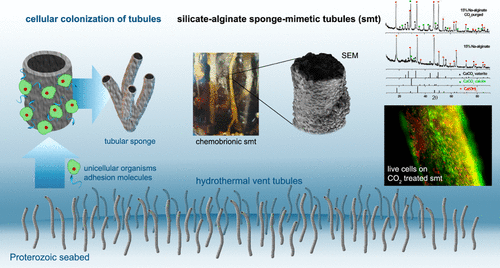当前位置:
X-MOL 学术
›
ACS Earth Space Chem.
›
论文详情
Our official English website, www.x-mol.net, welcomes your
feedback! (Note: you will need to create a separate account there.)
Chemobrionic Sponge-Mimetic Tubules for Probing the Template-Assisted Evolution of Ocean Sponges and Bioengineering Applications
ACS Earth and Space Chemistry ( IF 2.9 ) Pub Date : 2020-11-20 , DOI: 10.1021/acsearthspacechem.0c00207 Kamia Punia 1, 2, 3 , Michael Bucaro 4 , Yan Pevtsov 2, 4 , Christina Viso 1, 2 , Nicole Zubrich 2, 4 , Viktoriya Volkova 2, 4 , Alexey Bykov 3 , Kishan Kalluraya 1, 2, 3 , Sabina Shukurova 2, 4 , William L’Amoreaux 2, 3, 4 , Krishnaswami S. Raja 1, 2, 3
ACS Earth and Space Chemistry ( IF 2.9 ) Pub Date : 2020-11-20 , DOI: 10.1021/acsearthspacechem.0c00207 Kamia Punia 1, 2, 3 , Michael Bucaro 4 , Yan Pevtsov 2, 4 , Christina Viso 1, 2 , Nicole Zubrich 2, 4 , Viktoriya Volkova 2, 4 , Alexey Bykov 3 , Kishan Kalluraya 1, 2, 3 , Sabina Shukurova 2, 4 , William L’Amoreaux 2, 3, 4 , Krishnaswami S. Raja 1, 2, 3
Affiliation

|
This work expands the scope of chemobrionic chemistry to produce biopolymer-intercalated inorganic tubes that structurally and chemically resemble both oceanic hydrothermal vent tubules and the scaffolds of tubular sponges. The sponge-mimetic tubules (SMTs) are formed by seeding calcium chloride into a solution of concentrated sodium silicate–potassium phosphate containing solubilized biopolymers of the cyanobacterial origin. A carbonation step to increase the calcium carbonate content in the SMTs was optimized. Incorporation of biopolymers into the fabric of the SMTs was confirmed by energy-dispersive X-ray microanalysis and infrared spectroscopy and the mineral components identified by X-ray diffraction. SMT morphology was characterized by scanning electron microscopy. Experiments testing the hypothesis that biohybrid hydrothermal tubules in Paleoproterozoic oceans served as sites where unicellular eukaryotes colonized and evolved into early ocean sponges were performed: the compatibility of the SMTs with marine cells was demonstrated by live cell imaging of Pyrocystis lunula seeded onto alginate-incorporated SMTs. The choanoflagellate cell line Salpingocea rosetta, considered the ancestor of sponge choanocytes, was seeded onto alginate SMTs. Live cell imaging and confocal laser scanning microscopy confirmed the viability of the cells and actively feeding choanoflagellate cell assemblies on the SMTs were captured by video microscopy. The findings suggest that these hydrothermal vent models can support diverse eukaryotic life and validate the theory of a chemobrionic-linked origin of ocean sponges. The potential of using SMTs for tissue engineering was explored by using them as scaffolds for 3D cell culture of human fibroblasts.
中文翻译:

化学海绵模拟小管用于探测海洋海绵的模板辅助进化及其生物工程应用
这项工作扩大了化学离子交换化学的范围,以生产生物聚合物插层的无机管,其结构和化学结构均类似于海洋热液喷管和管状海绵的支架。海绵状小管(SMT)是通过将氯化钙接种到含有浓缩的蓝细菌来源的生物聚合物的硅酸钠-磷酸钾浓溶液中形成的。优化了增加SMT中碳酸钙含量的碳酸化步骤。通过能量色散X射线微分析和红外光谱确认了生物聚合物掺入SMT的织物中,并通过X射线衍射确定了矿物成分。通过扫描电子显微镜表征SMT的形态。褐藻(Pyrocystis lunula)接种到掺有藻酸盐的SMT上。将被认为是海绵软骨细胞祖先的鞭毛鞭毛细胞系Salpingocea rosetta接种到藻酸盐SMT上。活细胞成像和共聚焦激光扫描显微镜确认了细胞的活力,并通过视频显微镜捕获了SMT上主动喂入的鞭毛鞭毛细胞组件。这些发现表明,这些热液喷口模型可以支持各种真核生物,并验证了化学海绵相关的海洋海绵起源理论。通过将SMT用作人成纤维细胞3D细胞培养的支架,探索了将SMT用于组织工程的潜力。
更新日期:2020-12-17
中文翻译:

化学海绵模拟小管用于探测海洋海绵的模板辅助进化及其生物工程应用
这项工作扩大了化学离子交换化学的范围,以生产生物聚合物插层的无机管,其结构和化学结构均类似于海洋热液喷管和管状海绵的支架。海绵状小管(SMT)是通过将氯化钙接种到含有浓缩的蓝细菌来源的生物聚合物的硅酸钠-磷酸钾浓溶液中形成的。优化了增加SMT中碳酸钙含量的碳酸化步骤。通过能量色散X射线微分析和红外光谱确认了生物聚合物掺入SMT的织物中,并通过X射线衍射确定了矿物成分。通过扫描电子显微镜表征SMT的形态。褐藻(Pyrocystis lunula)接种到掺有藻酸盐的SMT上。将被认为是海绵软骨细胞祖先的鞭毛鞭毛细胞系Salpingocea rosetta接种到藻酸盐SMT上。活细胞成像和共聚焦激光扫描显微镜确认了细胞的活力,并通过视频显微镜捕获了SMT上主动喂入的鞭毛鞭毛细胞组件。这些发现表明,这些热液喷口模型可以支持各种真核生物,并验证了化学海绵相关的海洋海绵起源理论。通过将SMT用作人成纤维细胞3D细胞培养的支架,探索了将SMT用于组织工程的潜力。











































 京公网安备 11010802027423号
京公网安备 11010802027423号